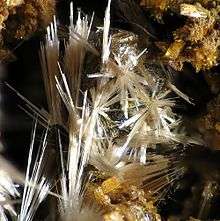Strunzite
Strunzite (Mn2+Fe3+2(PO4)2(OH)2{{·}}6H2O) is a light yellow mineral of the strunzite group, first discovered in 1957.[4]
| Strunzite | |
|---|---|
 Strunzite from Bavaria, Germany | |
| General | |
| Category | Mineral |
| Formula (repeating unit) | Mn2+Fe3+2(PO4)2(OH)2 · 6H2O[1] |
| Strunz classification | 8.DC.25 |
| Crystal system | Triclinic |
| Unit cell | a = 10.228(5) [Å], b = 9.837(5) [Å] c = 7.284(5) [Å]; α = 90.17(5)° β = 98.44(5)° γ = 117.44(5)°; Z = 2[2] |
| Identification | |
| Color | Straw yellow to brownish yellow |
| Crystal habit | Acicular[3] |
| Mohs scale hardness | 4 |
| Luster | vitreous |
| Streak | white |
| Specific gravity | 2.52 |
| Density | 2.52 g/cm3 |
| Pleochroism | Weak |
| References | [4] |
It crystallizes in the triclinic system and has a light, vitreous luster, a specific gravity of 2.52 and a Mohs hardness of 4. Associated minerals include beraunite, quartz and strengite.[4]
It is named after Hugo Strunz, a Professor of Mineralogy at Technical University, Berlin.[5]
References
| Look up strunzite in Wiktionary, the free dictionary. |
- "Strunzite R050619". RRUFF. Retrieved 8 April 2020.
- "Strunzite Mn2+Fe3+2(PO4)2(OH)2•6H2O" (PDF). Handbook of Mineralogy. Retrieved 8 April 2020.
- "General Strunzite Information". WebMineral. Retrieved 8 April 2020.
- "Strunzite". Mindat.org. Retrieved 8 April 2020.
- "Strunzite". Dakota Matrix Minerals. Retrieved 8 April 2020.
This article is issued from Wikipedia. The text is licensed under Creative Commons - Attribution - Sharealike. Additional terms may apply for the media files.